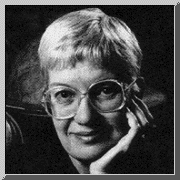 Vera
Cooper Rubin,
the second daughter of Philip and Rose Cooper was born in
Philadelphia, Pennsylvania on July 23, 1928. As a child she exhibited
a naive fascination for the stars which later, as an astronomer,
would motivate her to pursue answers to questions that most
scientists believed were obvious. Research she contributes to the
study of the universe has disproved previously accepted theories and
has left scientists struggling with the most baffling questions
yet.
Vera
Cooper Rubin,
the second daughter of Philip and Rose Cooper was born in
Philadelphia, Pennsylvania on July 23, 1928. As a child she exhibited
a naive fascination for the stars which later, as an astronomer,
would motivate her to pursue answers to questions that most
scientists believed were obvious. Research she contributes to the
study of the universe has disproved previously accepted theories and
has left scientists struggling with the most baffling questions
yet.
Vera graduated from Vassar College in 1948 with a bachelors degree in Astronomy and accompanied her new husband Bob Rubin, a physicist, to Cornell University. She completed her Master's degree there in 1951. At this time the big bang theory was becoming widely accepted. Vera presented her master's thesis to the American Astronomical Society\ in which she suggested that galaxies might be rotating around an unknown center, not just expanding out as described in the big bang theory. There was no scientific theory to explain this finding and as a 22 year old woman her ideas quickly earned a her negative reputation.
She completed her doctorate at Georgetown University in 1954 by taking night classes while her parents watched her 2 children and her husband waited in the car. Vera did not know how to drive. Her doctorate work showed that galaxies were not evenly distributed in the universe, but that in some areas there are more, and in some there are less. Again this went against the predictions of the big bang theory of an evenly distributed universe. ( More research gave her observations validity 15 years later.)
Vera taught and did research at Georgetown for several years and had 2 more children. Then in 1965 she got a job working for the Department of Terrestrial Magnetism, part of the Carnegie Institution of Washington. She is an astronomer there today. By examining the spectra, or light signatures of galaxies, she made another discovery in the early 1970's that altered dramatically our understanding of the universe. Newtonian laws of gravity predict that stars on the outside edge of a spiral galaxy would orbit slower than stars in the center of that galaxy; like planets orbiting around the sun. Vera's research shows that they do not. Stars orbiting the outside of a spiral galaxy travel just as fast as those orbiting closer to the center. As a result of her unexpected finding, scientists now believe that there is some huge, invisible mass exerting the gravitational force necessary for those outer stars to stay in orbit. Vera Rubin's research suggests that at least 90% of the universe is made of "dark matter," a substance that scientists today struggle to identify and describe. Rubin's work has shown that we still know only a fraction about what the universe is made of.
Bartusiak, M. (1993). Through a Universe Darkly: A Cosmic Tale of Ancient Ethers, Dark Matter, and the Fate of the Universe. New York: Avon Books.
Jacques Cattell Press (1992). American Men and Women of Science. 18th Ed. New Providence, NJ: R.R. Bowker.
Yount, L. (1994). American Profiles: Contemporary Women Scientists. New York: Facts on File.